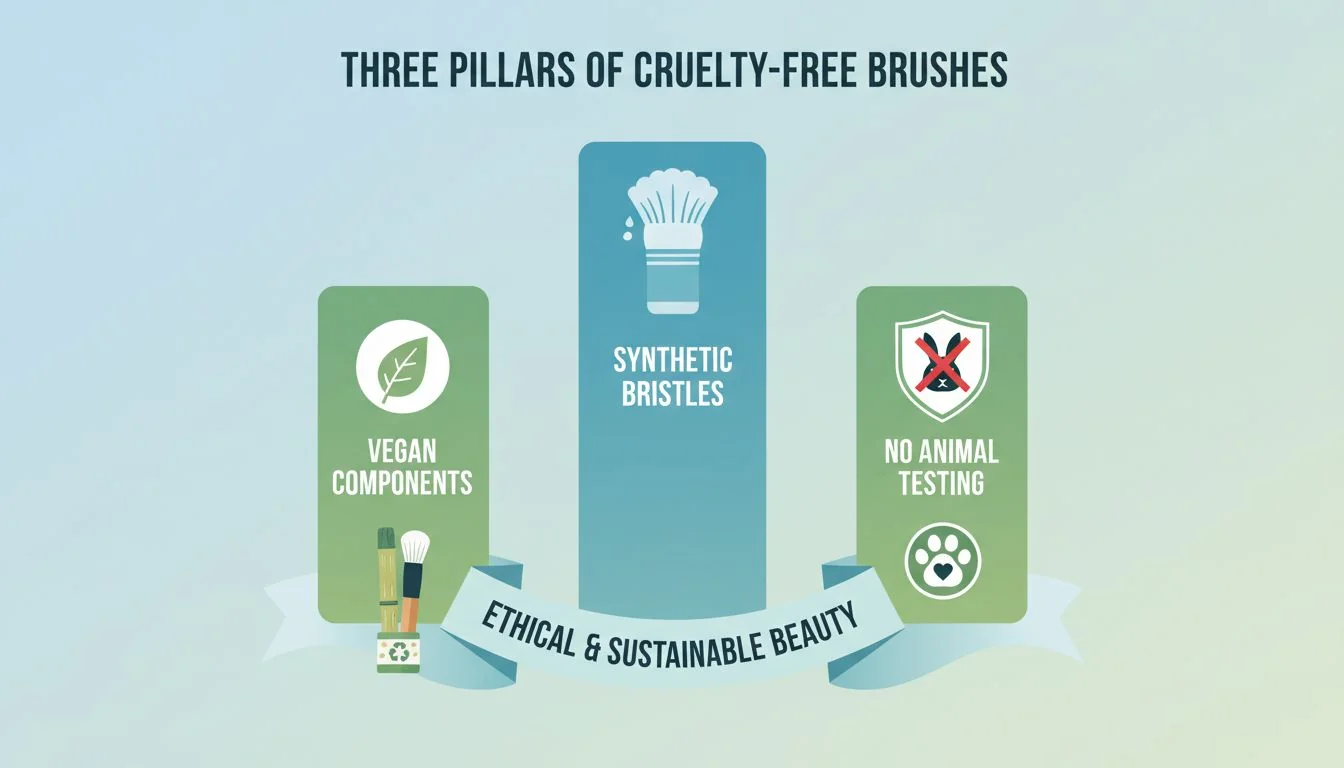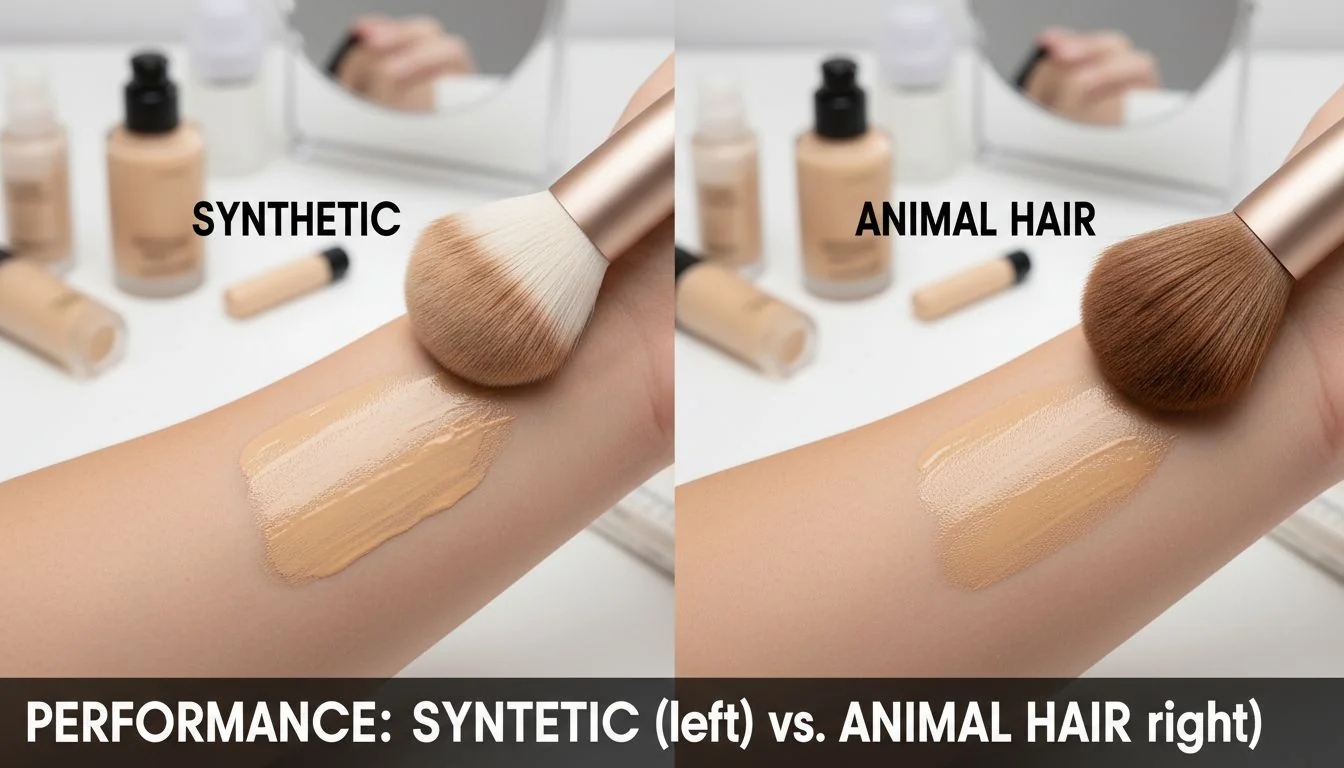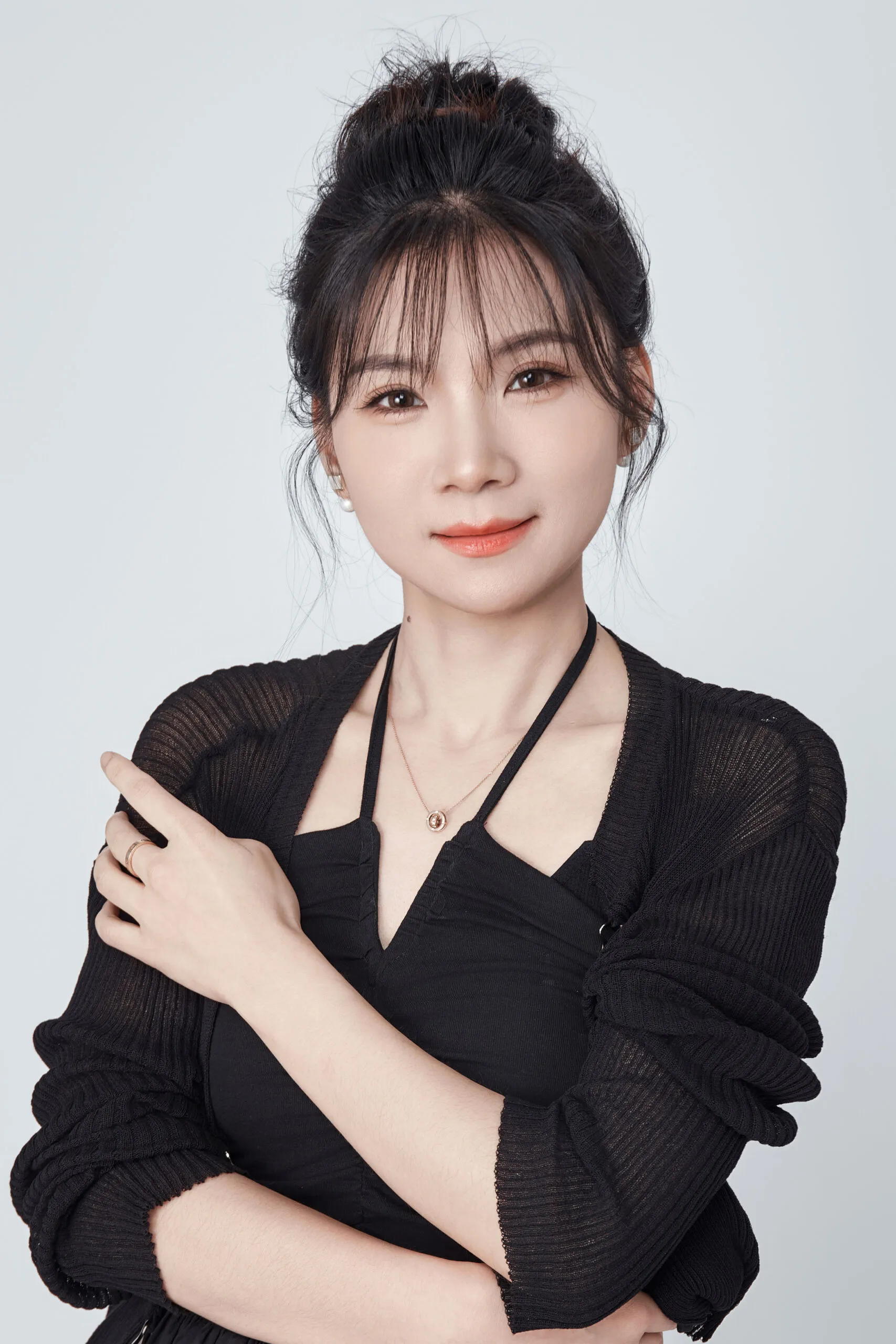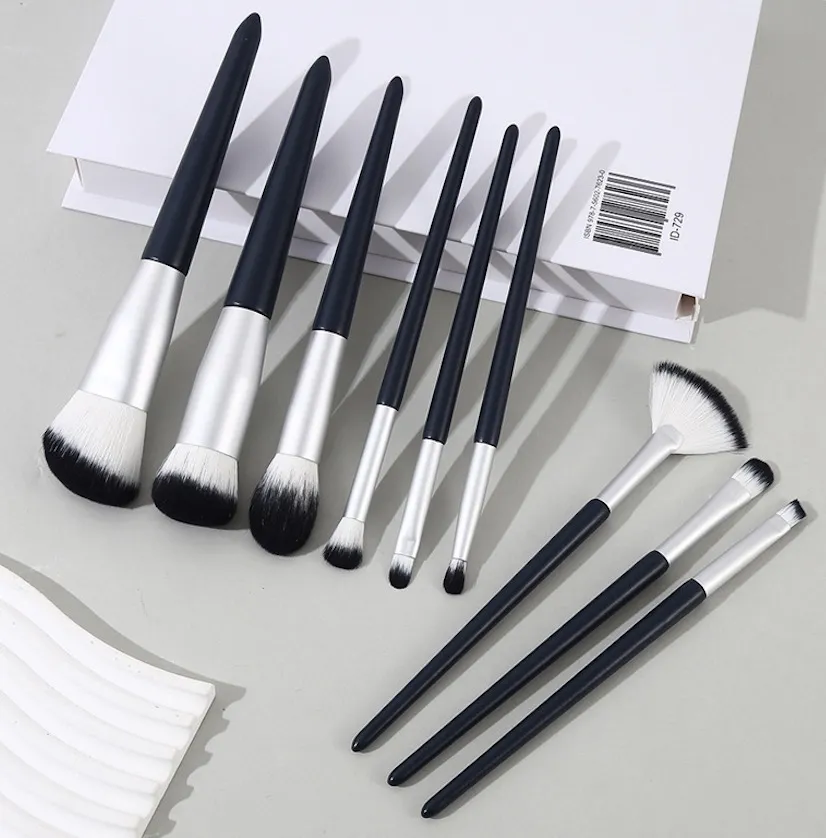You want to offer ethical products, but the world of "cruelty-free1" is confusing. Sourcing the wrong brushes can hurt your brand’s reputation. This guide makes it simple.
Cruelty-free makeup brushes use synthetic bristles2 (e.g., PBT/Taklon) instead of animal hair, deliver equal or better performance for creams and liquids, and align with growing vegan beauty demand—making them a 2025 essential for brands and retailers.

I’ve seen this shift happen right from the factory floor. Years ago, the best brushes were always made from animal hair. But today, the technology, the market, and consumer values have all changed. Brands that don’t adapt risk being left behind. For founders like you, understanding this trend isn’t just about ethics; it’s about smart business and future-proofing your product line. Let’s walk through exactly what you need to know to make the right choice for your brand.
All synthetic brushes are automatically 'vegan'.False
A brush can have synthetic bristles but use animal-derived glues or handle coatings, making it not truly vegan. Component-level verification is necessary.
Cruelty-free and vegan beauty is a durable market trend.True
Market data shows sustained single-digit CAGR, with the U.S. vegan cosmetics market projected to surpass $6 billion by 2030, indicating long-term consumer demand.
What counts as a “cruelty-free” brush in 2025?
You see "cruelty-free" on labels, but what does it really mean for a brush? Misunderstanding the term can lead to failed retailer audits and lost customer trust. Let’s clarify it.
A truly cruelty-free brush meets three key criteria. It must use 100% synthetic bristles, contain no animal-derived components in its glue or coatings, and be produced without any animal testing. This definition is now the standard for top retailers and certification bodies.

Beyond "No Animal Hair": A Component-Level Breakdown
When I work with brand founders, I tell them to think about the entire brush, not just the bristles. A truly vegan and cruelty-free claim has to be verified from top to bottom.
- 100% Synthetic Bristles: This is the most obvious part. The bristles must be made from materials like PBT, Taklon, or Nylon, with absolutely no animal hair mixed in.
- Animal-Free Components: This is where many brands get tripped up. The adhesive used to secure the bristles in the ferrule must be a synthetic epoxy, not a glue containing animal-derived products. Even the paint or coating on the handle must be confirmed as vegan.
- No Animal Testing: The finished brush, along with every single one of its components, must not have been tested on animals. This aligns with global standards set by organizations like PETA and Leaping Bunny.
Navigating Certifications and Retailer Standards
Getting your claims validated is key to earning customer trust. While you can self-certify, third-party logos from PETA or Leaping Bunny add a layer of authority. More importantly, major retailers like Sephora and Ulta have their own "Clean" and "Conscious Beauty" programs. To get listed in these popular sections, your products must pass their strict compliance checks. This means having documentation ready to prove every single one of your cruelty-free and vegan claims.
Leaping Bunny and PETA certifications are identical.False
While both certify for no animal testing, Leaping Bunny requires a more rigorous audit of a brand's entire supply chain and a fixed cut-off date for testing.
Retailers like Sephora and Ulta have their own standards for 'clean' and 'vegan' products.True
Brands must often provide detailed documentation to meet specific retailer requirements to be featured in their curated 'clean' or 'conscious beauty' programs.
Do synthetics outperform animal hair now?
Many brand founders I talk to worry that synthetic brushes won’t feel as luxurious or perform as well as natural hair. But sticking to that old belief means you’re missing out on incredible innovation. Modern synthetics are engineered for superior, more consistent performance.
Today’s advanced PBT and Taklon filaments offer low absorption and high consistency, making them perfect for applying creams and liquids without wasting product. Meanwhile, new engineered blends can now deliver the plush, soft pickup and controlled release needed for powders.

The Science of Synthetic Fibers
The debate between natural and synthetic is over for most applications. The science shows that high-quality synthetics are not just an ethical choice, but a better-performing one. The two most common materials we use are PBT and Nylon, each with distinct advantages. Understanding them helps you spec the perfect brush for every product in your line.
| Fiber Type | Key Properties | Best For | Why It Works |
|---|---|---|---|
| PBT / Taklon | Low moisture absorption, smooth surface, soft feel | Liquids, Creams, Serums | Doesn’t soak up product, ensuring a smooth, even application and less waste. |
| Nylon | High resilience, durable, good bend recovery | Powders, General Use | Strong and springy, making it great for brushes that need to hold their shape, like for brows or blending. |
Performance and Hygiene Advantages
Beyond the fiber science, synthetic brushes offer practical benefits your customers will love. Because they don’t have a porous cuticle like animal hair, they are far easier to clean and dry faster. This makes them more hygienic, as they are less likely to trap bacteria, dead skin cells, and old makeup. For your brand, this means fewer customer complaints about shedding, a longer-lasting product, and a powerful marketing message about clean, reliable beauty tools. When we engineer a powder brush, we can now blend different fiber diameters and use special tip-finishing techniques to create the same softness and pickup you’d expect from squirrel or goat hair, but with all the benefits of a synthetic.
Synthetic brushes absorb more liquid foundation than natural hair brushes.False
Synthetic fibers like PBT are non-porous and have low moisture absorption, meaning they apply product to the skin rather than soaking it up, unlike porous animal hair.
Engineered synthetic bristles can be finished with tapered tips to mimic the powder pickup of animal hair.True
Modern manufacturing processes can create synthetic filaments with flagged, tapered, or textured tips that effectively pick up and diffuse powder products.
How fast is cruelty-free beauty growing?
Is investing in a full cruelty-free brush line a safe bet for your business? Guessing market trends3 can lead to expensive overstock and missed opportunities. The data shows this isn’t a short-term fad; it’s a fundamental shift in the market.
Analyst reports show durable growth for vegan and cruelty-free cosmetics. The U.S. market alone is on track to grow at a 6.3% CAGR, projected to hit nearly $6.1 billion by 2030. This signals a safe and profitable area for brands to expand their tool assortments.

The Numbers Don’t Lie: Vegan Beauty’s Growth Trajectory
For a brand founder like you, this data is your green light. A steady growth rate of over 6% means that consumer demand4 is not only stable but expanding. When your customers are actively searching for vegan formulas, vegan tools are the natural next purchase. Aligning your brush collection with this trend de-risks your investment and positions your brand as modern and responsive. I always advise my clients to see this not as a cost, but as an investment in capturing a loyal, growing customer segment that makes purchasing decisions based on values.
From Niche to Mainstream: Retail Adoption Signals
The strongest proof of this trend is on the shelves of major beauty retailers. Go to the websites for Sephora, Ulta, or Credo Beauty. You’ll see prominent "Vegan" and "Cruelty-Free" filters that customers use to shop. These retailers are dedicating prime digital and physical space to these products because they sell. When a retail giant like Ulta builds an entire "Conscious Beauty" platform, it’s a clear signal to all brands: this is now a mainstream expectation. If you want to secure retail partnerships, having a fully compliant cruelty-free line is becoming a non-negotiable entry ticket. It’s a fast-follow category that shows you understand where the industry is headed.
The demand for vegan beauty is declining as consumers focus on other trends.False
Market projections show the opposite. The global vegan cosmetics market is growing steadily, with a CAGR of around 6.3% in the U.S., indicating strong and sustained consumer interest.
Major beauty retailers are creating dedicated sections and filters for vegan products.True
Retailers like Sephora and Ulta have implemented 'vegan' and 'cruelty-free' filters and curated collections, responding to high consumer search volume and purchasing behavior for these categories.
What is the buyer’s checklist for locking in quality?
You’ve found a potential supplier, but how do you guarantee the bulk order will match that perfect first sample? Vague specifications are the number one cause of quality issues like shedding, loose handles, and inconsistent performance. Use this checklist to protect your brand and your investment.
To lock in quality, you need a detailed tech pack with fiber specs, ferrule material, and adhesive type. You also need to define standardized QC tests for pulling, shedding, and durability, and request compliance documents like REACH/Prop 65 before releasing a purchase order.

Step 1: Build Your Technical Pack (Tech Pack)
This is your blueprint for manufacturing. A detailed tech pack leaves no room for error or substitutions. When I was starting my own factory, I learned that what isn’t written down will be interpreted. Be specific. Your supplier should be able to build the exact same brush a year from now using this document.
| Component | Specification | Example |
|---|---|---|
| Bristles | Fiber Type, Diameter (microns), Tip Finish, Density | PBT, 0.07mm, Tapered Tips, 80% Density |
| Ferrule | Material, Crimp Style, Color | Brass, Double Crimp, Pantone 123 C |
| Handle | Material, Source, Finish, Length | FSC-Certified Birch Wood, Matte Paint, 120mm |
| Adhesive | Type | Two-Part Epoxy Resin |
| Printing | Method, Color, Durability Requirement | Silk Screen, White, Pass Logo Rub Test |
Step 2: Define Your Quality Control (QC) Tests
Agree on QC tests and passing criteria before production begins. This ensures you and your supplier have the same definition of "good quality." Ask for a Certificate of Analysis (COA) with the results from these tests before you approve the bulk shipment.
| Test | Method | Acceptance Criteria |
|---|---|---|
| Pull Test | Apply 500g of force to a tuft of bristles. | No more than 2-3 bristles pull out. |
| Shedding Test | Rub the brush head on an abrasive surface for 100 strokes. | Fewer than 10 bristles shed. |
| Adhesive Test | Soak the brush head in water/solvent for 24 hours. | No loosening of the ferrule or bristle loss. |
| Logo Rub Test | Rub the logo with an alcohol-soaked cloth 50 times. | Logo remains intact with no fading. |
Step 3: Verify Compliance and Documentation
This final step protects your brand from legal issues and ensures you can pass retailer audits. Don’t just take a supplier’s word for it—ask for the paperwork. This is a major pain point for founders, and a reliable partner should provide this without hesitation. Request copies of REACH (for EU) and Prop 65 (for California) declarations, FSC certificates for wood handles, and written confirmation of component-level vegan status.
A verbal agreement on quality is sufficient for mass production.False
Verbal agreements lead to misunderstandings. A detailed, written tech pack and defined QC tests are essential to ensure the bulk order matches the approved sample.
A double-crimped brass ferrule is more durable than a single-crimped aluminum one.True
Brass is a stronger, more corrosion-resistant metal than aluminum, and a double crimp provides two points of pressure to securely hold the handle and bristles, preventing wobbling and separation.
Conclusion
Switching to cruelty-free brushes is a smart move for your brand, customers, and bottom line. It’s about combining modern ethics with superior performance to future-proof your business.
References
-
Understand the true meaning of cruelty-free and its importance in consumer trust. ↩
-
Explore how synthetic bristles outperform animal hair in performance and hygiene. ↩
-
Stay informed on the growth and future of cruelty-free beauty products. ↩
-
Explore the factors driving consumer preferences for cruelty-free options. ↩


